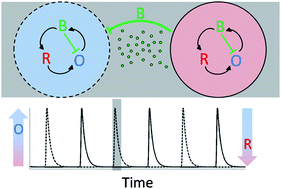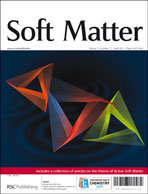We experimentally and computationally study the dynamics of interacting oscillating Belousov–Zhabotinsky (BZ) droplets of ∼120 µm diameter separated by perfluorinated oil and arranged in a one-dimensional array (1D). The coupling between BZ droplets is dominated by inhibition and is strongest at low concentrations of malonic acid (MA) and small droplet separations. A microfluidic chip is used for mixing the BZ reactants, forming monodisperse droplets by flow-focusing and directing them into a hydrophobized 100 µm diameter capillary. For samples composed of many drops and in the absence of well defined initial conditions, the anti-phase attractor, in which adjacent droplets oscillate 180° out-of-phase, is observed for strong coupling. When the coupling strength is reduced the initial transients in the phase difference between neighboring droplets persist until the BZ reactants are exhausted. In order to make quantitative comparison with theory, we use photosensitive Ru(bipy)32+-catalyzed BZ droplets and set both boundary and initial conditions of arrays of small numbers of oscillating BZ droplets with a programmable illumination source. In these small collections of droplets, transient patterns decay rapidly and we observe several more complex attractors, including ones in which some adjacent droplets are in-phase. Excellent agreement between experiment and numerical simulations is achieved.

You have access to this article
 Please wait while we load your content...
Something went wrong. Try again?
Please wait while we load your content...
Something went wrong. Try again?


 Please wait while we load your content...
Please wait while we load your content...